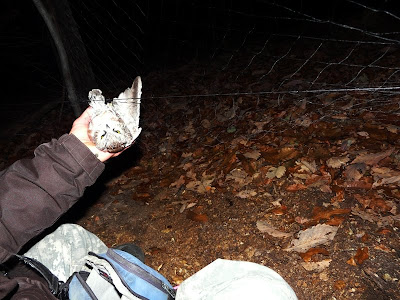Saw-whet Owl Banding '10
I spent Halloween night assisting in research on the Northern Saw-whet Owl. My first experience with the project was in 2006, and I have tried to make it at least once every fall. (Click here to see past year's photos.) Despite the sacrifice of sleep, it is great to spend the evening in the woods. Even the down time between net checks can be enjoyable; listening to owls and coyotes and watching the stars. It got a little cool, but it wasn't bad if you were bundled up. The night was shaping up to be a good night for owl migration, since there wasn't a bright moon, and the previous night's wind was from the north.
We got set up at the station in Yellowwood State Forest right before dark. (You can't just leave the nets up all day.) The first net check had no owls. After waiting a half hour, we went to check again. In the first net (of nine, I think) there were two owls. I helped stabilize one of them, so that they wouldn't flop around, potentially hurting themselves or tangling themselves more. We soon found a third owl, which fit well, since there were three volunteers. The bander came and got the owls untangled. It is pretty impressive how tangled they get, which is partially due to their bodies being so tiny, while their feathers are very fluffy. And they have very sharp little talons that grasp tightly. When we got the owls out, we would put them in little tubes. Before we could get the three out, three more flew into the net. In the above picture, I am holding one owl in the net, while I have another owl in my coat.

We got the six owls weighed, measured, and banded as quickly as we could. Here, the bander holds up one of the owls. I am still amazed at how little they weigh, with Sibley listing their weight at 80 grams or 2.8 ounces! We caught some small males that might have been tinier. All in all, we caught nine owls. It was a good night.

Recording the data. You can see one of the tubes with an owl in it sitting on the notebook. Some owls were calm, others would try to scrunch their way out of the tube or to get their little needle-talons out to your hand. They are so sharp, that they don't hurt much at all. They just go in and come out cleanly. While they may not enjoy the banding process per se, the owls aren't hurt, and valuable information is collected.

Here I am, holding up one of my owls, but the owl forgot to look.

One of the most fun experiences is releasing the owls. The last owl I released was a larger (relatively speaking), calm female. I turned off my light and walked off down the fire lane. When I got a ways down the lane, I set her on my coat sleeve. Most of the time, they fly right away. She sat on my arm for twenty minutes, while we both stood still in the night woods. My eyes adjusted much slower than hers, but I could soon see her looking around and watching me. It was magical to spend some time with these mysterious little birds.


1 comment:
Very cool about the slow release! Thanks for sharing the experience. I may end up getting to do this again in Virginia this week, but I'm not sure yet.
Post a Comment